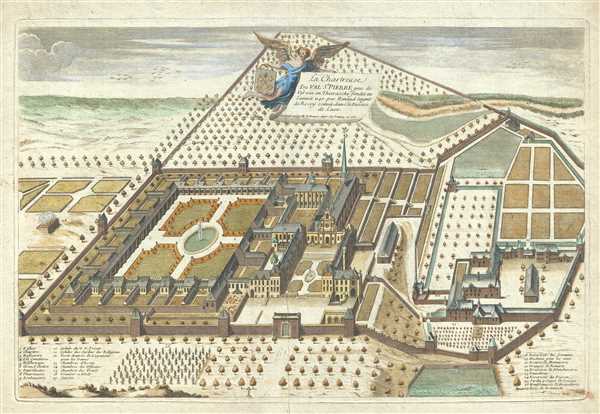1716 de Hangest View of La Chartreuse Monastery in Val-Saint-Pierre, France
ChartreuseValStPierre-dehangest-1716$500.00

Title
La Chartreuse du Val St. Pierre pres de Vervin en Thierasche fondée en l'année 1140 par Renaud Seignr. De Rosoy scituée dans le Diocese de Laon.
1716 (dated) 12.5 x 19.25 in (31.75 x 48.895 cm)
1716 (dated) 12.5 x 19.25 in (31.75 x 48.895 cm)
Description
This is a surprisingly rare 1716 M. de Hangest de Fantigny view of the Carthusian monastery at Val-Saint-Pierre, a hamlet near the town of Braye-en-Thiérache in northeastern France. Carthusian monks make Chartreuse, a green French liqueur that is distilled and aged with 130 herbs, plants, and flowers and is named after the monks' Grand Chartreuse monastery, located near Grenoble. The distillery is located in the nearby town of Voiron. The view depicts the whole of the monastery, along with the fields and plantations surrounding the monastery. Illustrated in striking detail, a rather comprehensive understanding of the layout of the monastery is provided. Twenty-seven different locations and buildings in and around the monastery are numerically identified, with the tables bearing the corresponding labels situated along the bottom border. The church, cemeteries, library, pharmacy, bakery, and cooperage are identified, along with the rooms belonging to the monks and the entrance and rooms dedicated to female visitors. The gardens and 'wood of the house,' or the various groves of trees around the monastery, are also labeled. Individual trees are illustrated, along with the bricks and windows of the buildings and the fountain in the center of the courtyard. Not much of the monastery remains today. All of the buildings were destroyed in 1790 during the French Revolution. Some small odds and ends remain, mostly containers from the pharmacy.
This view was drawn by M. de Hangest de Fantigny and engraved by Drevet in 1716. We have been able to identify only two examples, both at the Bibliothèque Nationale de France.
This view was drawn by M. de Hangest de Fantigny and engraved by Drevet in 1716. We have been able to identify only two examples, both at the Bibliothèque Nationale de France.
Condition
Very good. Blank on verso.
References
OCLC 767126250.

